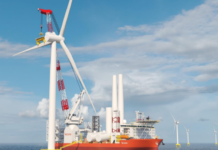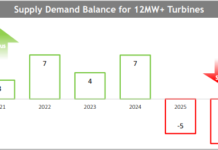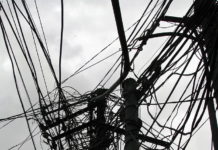A friend recently asked me how to invest in the Pickens Plan. I named a stock (see below).
He then surprised me by saying "You are the fifth person I’ve asked, and no one else knew how. Several said it could not be done."
You can invest in T. Boone Pickens’s plan. Here’s how:
The Plan
T. Boone’s plan is both simple and audacious.
- We will build wind farms all over the Great Plains.
- Build the necessary transmission to get that electricity to cities, displacing natural gas used in electricity generation for the use in automobiles.
- This will give us an alternative, clean transportation fuel, to replace oil, which has peaked.
- It will also cause an economic revival for rural America.
There are investments available for you to profit from all of these steps (so long as they are more successful than is currently expected by the market.) Most of the links below are to articles about how the company fits into the clean energy picture.
1. Wind Farm Investments
To profit from the massive build out of wind farms, look no further than wind turbine manufacturers, and other wind related stocks.
- Among individual wind stocks, Zoltek (ZOLT) is currently looking relatively cheap because of a negative analyst report. If you believe T. Boone will pull it off, now is a probably a good buying opportunity.
- T. Boone is buying his turbines from a longtime favorite of this blog, General Electric (NYSE:GE).
- If you want to play wind without picking particular manufacturers or suppliers, try one of the new wind ETFs, FAN or PWND.
- Makers of power conversion devices to turn the the "wild AC" produced by wind turbines into more domesticated power should also benefit.
2. Transmission Investments
We’ve been pushing transmission investments at this blog for a long time. It’s nice to have an oilman hop on our bandwagon. Here are some of our top picks.
- Long distance transmission from the Great Plains to coastal cities could be most efficiently accomplished with new high voltage DC (HVDC) lines. Leaders in HVDC are the ABB Group (NYSE:ABB) and Siemens (NYSE:SI).
- A more speculative play, Composite Technology Corporation (CPTC.OB), has technology not only for a superior transmission cable, but also for an innovative wind turbine.
- Other interesting ways to play transmission are ITC Group (NYSE:ITC) a Midwestern transmission-only utility, and two I highlighted in February, National Grid (NYSE:NGG) and Quanta Services (NYSE:PWR).
3. Natural Gas
- The most direct investment in the Plan is natural gas fueling stations. Clean Energy Fuels (NASD:CLNE), operates fueling stations for natural gas fleets, as well as providing fueling stations to the public. T. Boone owns about 37% of the company personally, serves on the board, and founded the predecessor company in 1997. His wife owns another 7%. Although he just recently hit the media with it, T Boone has been thinking about peak oil for a long time. (This is the stock I told my friend about.)
4. Rural Resurgence
- Massive wind investment should be good for real estate values in rural towns in windy areas, mainly the great plains. You don’t have to buy the land that the wind farm is on to benefit; the economic revival should help land values in towns nearby, too. The workers have to live, eat, shop, and sleep somewhere, and county tax rolls will benefit, leading to improved public services.
- Another way to play the same trend would be to invest in a Midwestern REIT, such as Investors Real Estate Trust (NASD:IRET). While this should profit by an improving Midwestern economy, I’d prefer a REIT with a rural focus, but have been unable to find one.
Quibbles
- Insulation. Pickens dismisses insulating homes as "too slow." I’d guess his real problem is that he has no way to profit from insulation on a large scale, so he’s not going to waste his money and time promoting it. But you can profit from insulating homes, which not only will save natural gas used in heating, but is usually an excellent investment for the homeowner. About 21% of US natural gas is goes to residential uses, nearly as much as is used in electricity generation. To invest in insulating homes, Owens Corning (NYSE:OC) is a good bet. Another home efficiency improvement is a ground source heat pump. Waterfurnace Renewable Energy (WFFIF.PK) sells extremely efficient ground source heat pumps, which can displace gas used for heating with a smaller amount of electricity from wind.
- Intermittancy. Pickens oversimplifies when he says we can simply slot in 22% of electricity from wind power and displace electricity from gas. At the current low penetrations, wind will mostly displace natural gas, but without other sources of dispatchable power, such as Concentrating Solar Power (CSP), and/or much improved smart grid infrastructure, wind will begin to displace baseload generation such as coal (or the wind generation will be curtailed.) Displacing coal is a good thing, not a bad thing, but Pickens is most likely not talking about it because it would muddy his message.
The improved transmission called for in the plan will help, but in no case can wind simply displace natural gas one for one on our electric grid. It’s like trying to fit a square peg in a round hole. You either have to trim down the peg (wind curtailment) or make the hole square using demand response and other smart grid technologies. - Water. Some environmentalists have been protesting the whole plan as a shell game to win permission for a water pipeline, to bring water pumped from an ancient aquifer to thirsty Texas cities. While pumping water from an ancient aquifer is not a good idea, opponents are too simplistic. First, no account is given to the water which would otherwise be used in electricity generation without the wind farm. Second, the water will likely be pumped with wind power when electricity prices on the grid are low. This will even out the net output of the wind farm, and displace less clean electricity which would otherwise be used to pump or purify water elsewhere. Finally, if the giant wind and transmission project is really just a quid pro quo to get us to accept the pipeline, he’s essentially offering us a $10 billion plus wind power quid so that we’ll ignore the $1.5 billion water pipeline (and the powers of immanent domain which are necessary to put the necessary transmission in place) quo. It sounds like a good deal to me.
DISCLOSURE: Tom Konrad and/or his clients own ZOLT, GE, ABB, SI, CPTC, ITC, NGG, PWR, CLNE, OC, WFIFF, .
DISCLAIMER: The information and trades provided here and in the comments are for informational purposes only and are not a solicitation to buy or sell any of these securities. Investing involves substantial risk and you should evaluate your own risk levels before you make any investment. Past results are not an indication of future performance. Please take the time to read the full disclaimer here.









Boone’s plan is interesting but somehow, when I first heard it, I did some math and figured it’d cost $2.5 trillion.
That being said… it would be $2.5 trillion well spent (or likely “guaranteed”) relative to (1) what are gov’t normally spends capital on, (2) what they’ll likely pay for the housing bailout and/or (3) the war in iraq!
$2.5 is around the same number I’ve heard bandied about… but it would not be all (or even mostly) government money… most of it would be private moeny, like Pickens’s own.
I never used the word trillion until lately. Trillion never entered any of my analysis. Lately, thanks to the mortgage fiasco and the Iraq war, trillion has become a word that I regretfully use. It’s truly an sign of inflation.
Anyway, the total enterprise value of all the utility companies in the XLU index is only $800 billion. So, to tell people we need $2.5 trillion in the next decade to augment the $800 billion… well that’s going to be tough. Then again, at current oil prices we send $700 billion overseas every year (the entire grid!). Quite a conundrum.
USA will need to go on an energy diet because that’s too much capital even for the gov’t. Interesting times… great change brings about great opportunity!
The money need not come from the utilities. Pickens’ $10-$20 billion didn’t. Why do you think I wrote the article? It’s about more than making money (although that’s the motivator.)
PS: stop playing games with your URL… the fake email address is no big deal, but if you don’t want to tell people what your website is, just leave the field blank.